2016 MERCEDES-BENZ GLE tow bar
[x] Cancel search: tow barPage 264 of 450
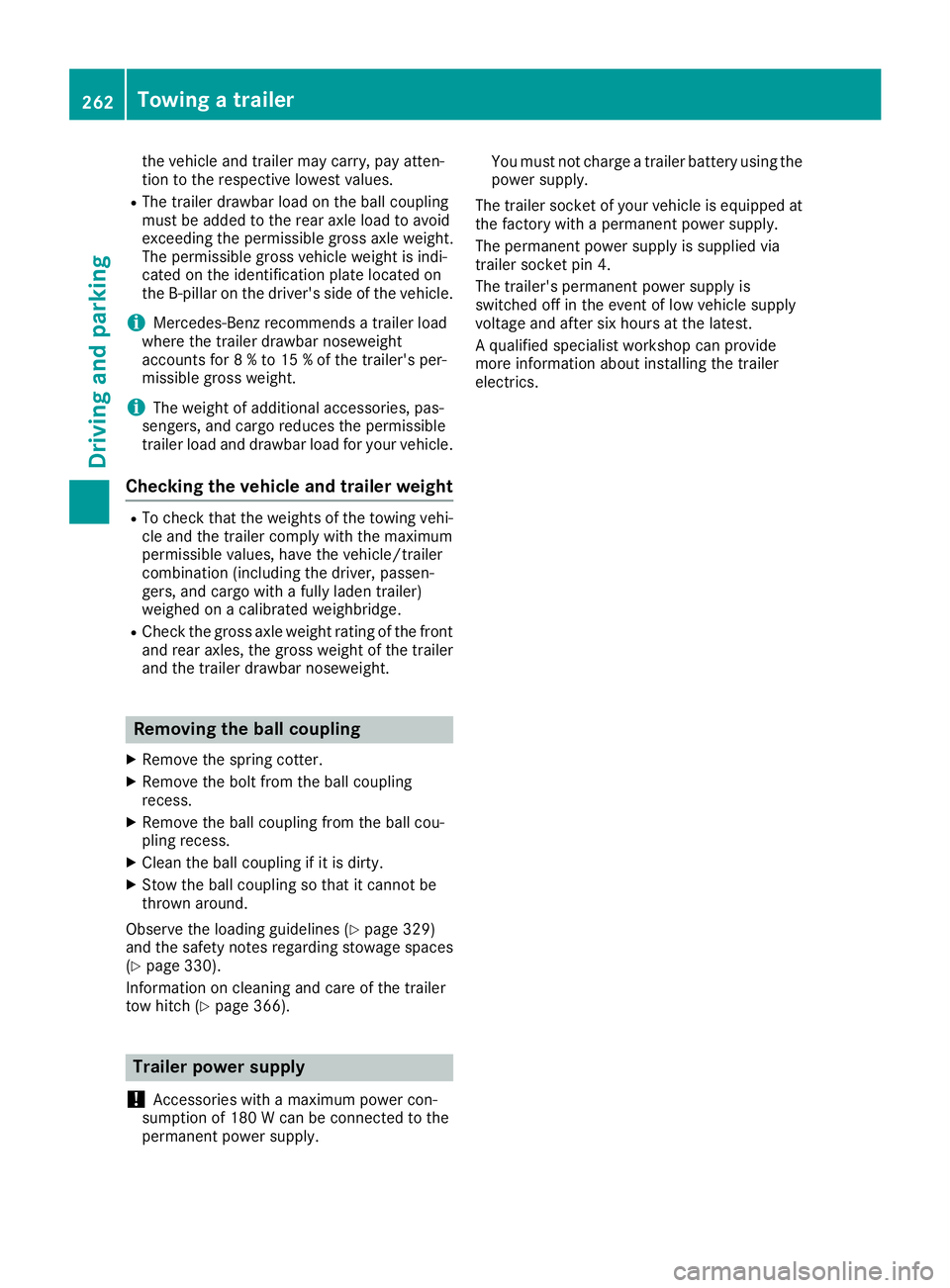
the vehicle and trailer may carry, pay atten-
tion to the respective lowest values. R
The trailer drawbar load on the ball coupling
must be added to the rear axle load to avoid
exceeding the permissible gross axle weight.
The permissible gross vehicle weight is indi-
cated on the identification plate located on
the B-pillar on the driver's side of the vehicle.
i Mercedes-Benz recommends a trailer load
where the trailer drawbar noseweight
accounts for 8 % to 15 % of the trailer's per-
missible gross weight.
i The weight of additional accessories, pas-
sengers, and cargo reduces the permissible
trailer load and drawbar load for your vehicle.
Checking the vehicle and trailer weight R
To check that the weights of the towing vehi-
cle and the trailer comply with the maximum
permissible values, have the vehicle/trailer
combination (including the driver, passen-
gers, and cargo with a fully laden trailer)
weighed on a calibrated weighbridge. R
Check the gross axle weight rating of the front
and rear axles, the gross weight of the trailer
and the trailer drawbar noseweight.
Removing the ball coupling X
Remove the spring cotter. X
Remove the bolt from the ball coupling
recess. X
Remove the ball coupling from the ball cou-
pling recess. X
Clean the ball coupling if it is dirty. X
Stow the ball coupling so that it cannot be
thrown around.
Observe the loading guidelines ( Y
page 329)
and the safety notes regarding stowage spaces
( Y
page 330).
Information on cleaning and care of the trailer
tow hitch ( Y
page 366).
Trailer power supply
! Accessories with a maximum power con-
sumption of 180 W can be connected to the
permanent power supply. You must not charge a trailer battery using the
power supply.
The trailer socket of your vehicle is equipped at
the factory with a permanent power supply.
The permanent power supply is supplied via
trailer socket pin 4.
The trailer's permanent power supply is
switched off in the event of low vehicle supply
voltage and after six hours at the latest.
A qualified specialist workshop can provide
more information about installing the trailer
electrics.262
Towing a trailer
Driving an d parking
Page 375 of 450
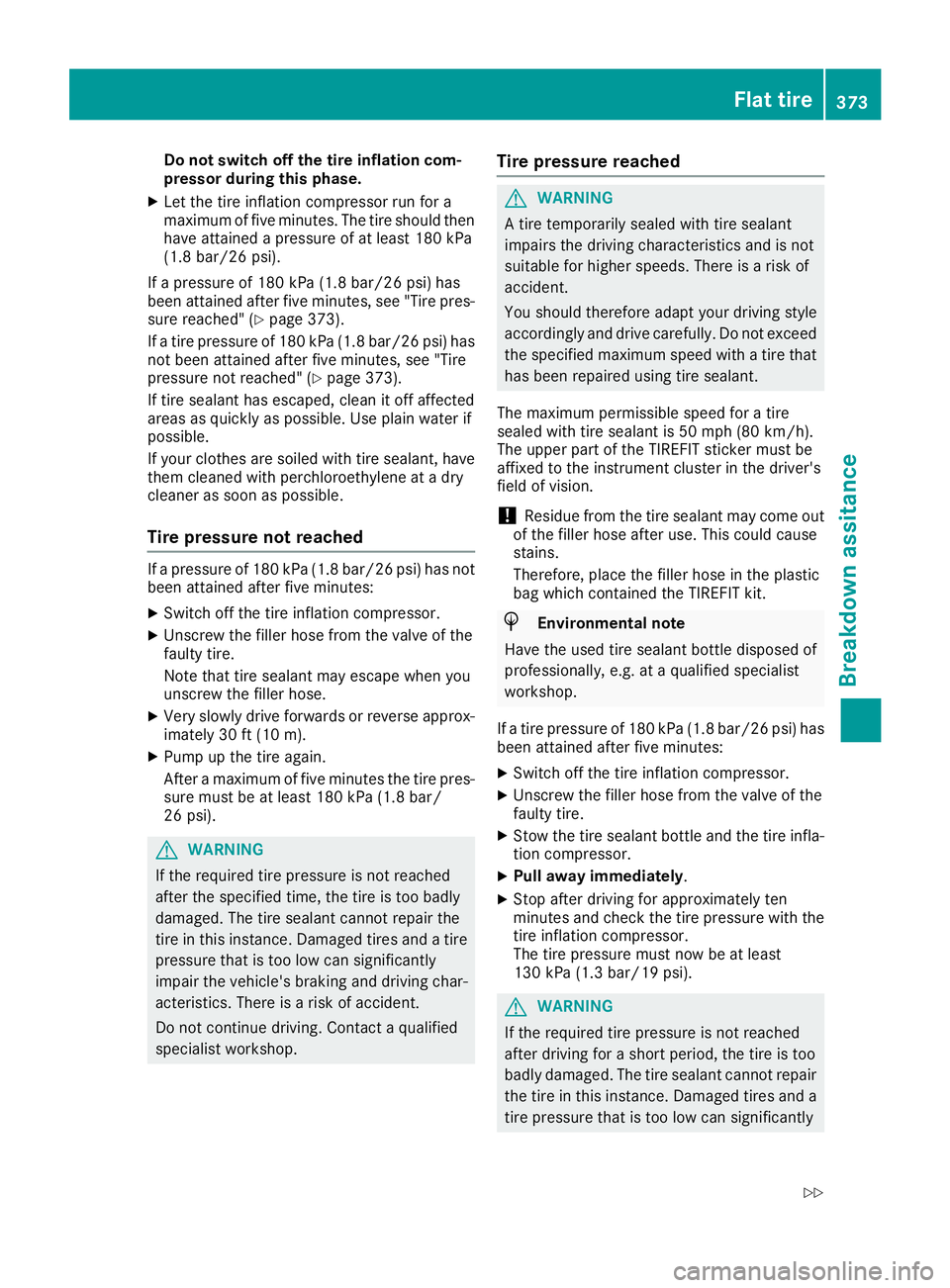
Do not switch off th e tire inflation com -
pressor during this phase .X
Let th e tire inflation compressor run for a
maximum of fiv e minutes. The tire should then
hav e attained a pressur e of at least 18 0 kP a
(1. 8 bar/2 6 psi) .
If a pressur e of 18 0 kP a (1. 8 bar/26 psi) has
been attained after fiv e minutes, see "Tir e pres-
sur e reached" ( Y
page 373).
If a tire pressur e of 18 0 kP a( 1.8 bar/26 psi) has
not been attained after five minutes, see "Tire
pressure not reached" ( Y
page 373).
If tire sealant has escaped, clean it off affected
areas as quickly as possible. Use plain water if
possible.
If your clothes are soiled with tire sealant, have
them cleaned with perchloroethylene at a dry
cleaner as soon as possible.
Tire pressure not reached If a pressure of 180 kPa (1.8 bar/26 psi) has not
been attained after five minutes: X
Switch off the tire inflation compressor. X
Unscrew the filler hose from the valve of the
faulty tire.
Note that tire sealant may escape when you
unscrew the filler hose. X
Very slowly drive forwards or reverse approx-
imately 30 ft (10 m). X
Pump up the tire again.
After a maximum of five minutes the tire pres-
sure must be at least 180 kPa (1.8 bar/
26 psi).
G WARNING
If the required tire pressure is not reached
after the specified time, the tire is too badly
damaged. The tire sealant cannot repair the
tire in this instance. Damaged tires and a tire
pressure that is too low can significantly
impair the vehicle's braking and driving char-
acteristics. There is a risk of accident.
Do not continue driving. Contact a qualified
specialist workshop. Tire pressure reached
G WARNING
A tire temporarily sealed with tire sealant
impairs the driving characteristics and is not
suitable for higher speeds. There is a risk of
accident.
You should therefore adapt your driving style
accordingly and drive carefully. Do not exceed
the specified maximum speed with a tire that
has been repaired using tire sealant.
The maximum permissible speed for a tire
sealed with tire sealant is 50 mph (80 km/h).
The upper part of the TIREFIT sticker must be
affixed to the instrument cluster in the driver's
field of vision.
! Residue from the tire sealant may come out
of the filler hose after use. This could cause
stains.
Therefore, place the filler hose in the plastic
bag which contained the TIREFIT kit.
H Environmental note
Have the used tire sealant bottle disposed of
professionally, e.g. at a qualified specialist
workshop.
If a tire pressure of 180 kPa (1.8 bar/26 psi) has
been attained after five minutes: X
Switch off the tire inflation compressor. X
Unscrew the filler hose from the valve of the
faulty tire. X
Stow the tire sealant bottle and the tire infla-
tion compressor. X
Pull away immediately .X
Stop after driving for approximately ten
minutes and check the tire pressure with the
tire inflation compressor.
The tire pressure must now be at least
130 kPa (1.3 bar/19 psi).
G WARNING
If the required tire pressure is not reached
after driving for a short period, the tire is too
badly damaged. The tire sealant cannot repair
the tire in this instance. Damaged tires and a
tire pressure that is too low can significantly Flat tire 373
Breakdown assitance Z
Page 410 of 450
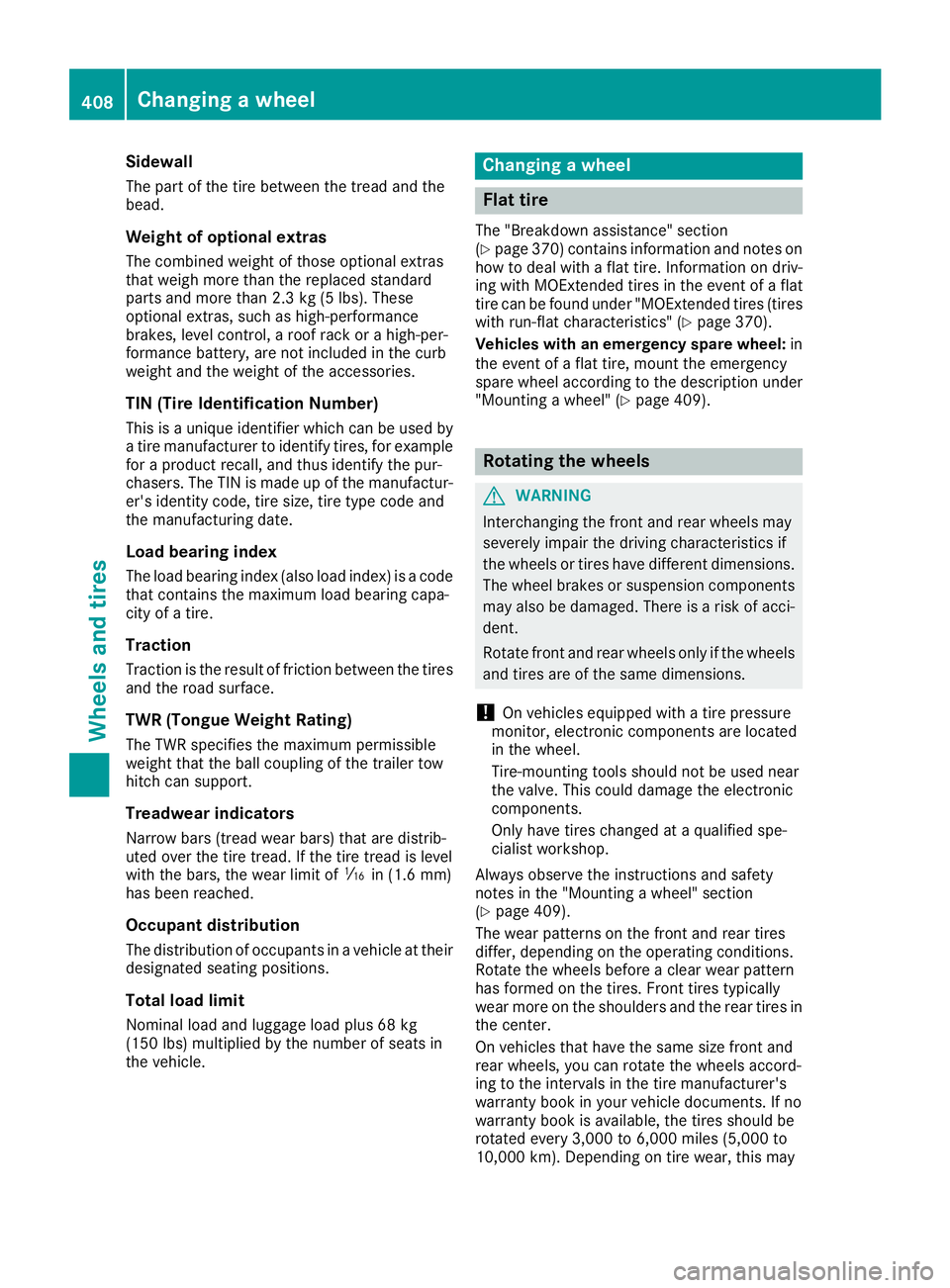
Sidewall The part of the tire between the tread and the
bead.
Weight of optional extras The combined weight of those optional extras
that weigh more than the replaced standard
parts and more than 2.3 kg (5 lbs). These
optional extras, such as high-performance
brakes, level control, a roof rack or a high-per-
formance battery, are not included in the curb
weight and the weight of the accessories.
TIN (Tire Identification Number) This is a unique identifier which can be used by
a tire manufacturer to identify tires, for example
for a product recall, and thus identify the pur-
chasers. The TIN is made up of the manufactur-
er's identity code, tire size, tire type code and
the manufacturing date.
Load bearing index The load bearing index (also load index) is a code
that contains the maximum load bearing capa-
city of a tire.
Traction Traction is the result of friction between the tires
and the road surface.
TWR (Tongue Weight Rating) The TWR specifies the maximum permissible
weight that the ball coupling of the trailer tow
hitch can support.
Treadwear indicators Narrow bars (tread wear bars) that are distrib-
uted over the tire tread. If the tire tread is level
with the bars, the wear limit of �
Page 447 of 450
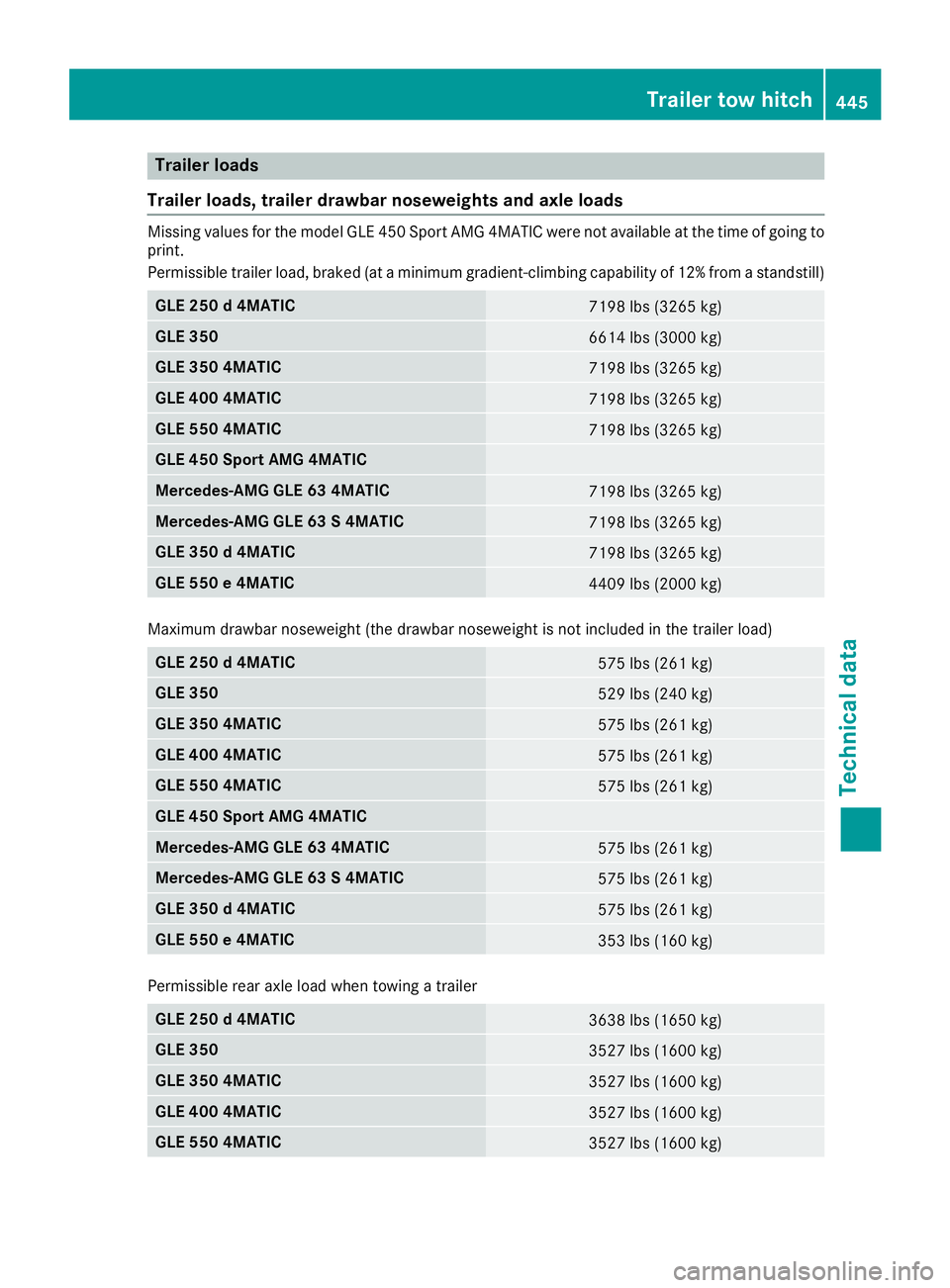
Trailer loads
Trailer loads, trailer drawbar noseweights and axle loads Missing values for the model GLE 450 Sport AMG 4MATIC were not available at the time of going to
print.
Permissible trailer load, braked (at a minimum gradient-climbing capability of 12% from a standstill)
GLE 250 d 4MATIC
7198 lbs (3265 kg )
GL E 350
6614 lbs (3000 kg )
GL E 350 4MATIC
7198 lbs (3265 kg )
GL E 400 4MATIC
7198 lbs (3265 kg )
GL E 550 4MATIC
7198 lbs (3265 kg )
GL E 450 Sport AMG 4MATIC
Mercedes-AMG GLE 63 4MATIC
7198 lbs (3265 kg )
Merc edes-AMG GLE 63 S 4MATIC
7198 lbs (3265 kg )
GL E 350 d 4MATIC
7198 lbs (3265 kg )
GL E 550 e 4MATIC
4409 lbs (2000 kg )
Maximu m dr awbar noseweight (the drawbar noseweight is not included in the trailer load)
GLE 250 d 4MATIC
575 lbs (26 1 kg )
GL E 350
529 lbs (24 0 kg )
GL E 350 4MATIC
575 lbs (26 1 kg )
GL E 400 4MATIC
575 lbs (26 1 kg )
GL E 550 4MATIC
575 lbs (26 1 kg )
GL E 450 Sport AMG 4MATIC
Mercedes-AMG GLE 63 4MATIC
575 lbs (26 1 kg )
Merc edes-AMG GLE 63 S 4MATIC
575 lbs (26 1 kg )
GL E 350 d 4MATIC
575 lbs (26 1 kg )
GL E 550 e 4MATIC
353 lbs (16 0 kg )
Permissibl e re ar axle load when towing a trailer
GLE 250 d 4MATIC
3638 lbs (1650 kg )
GL E 350
3527 lbs (1600 kg )
GL E 350 4MATIC
3527 lbs (1600 kg )
GL E 400 4MATIC
3527 lbs (1600 kg )
GL E 550 4MATIC
3527 lbs (1600 kg )Traile r to w hi tch 445
Technical data Z
Page 448 of 450
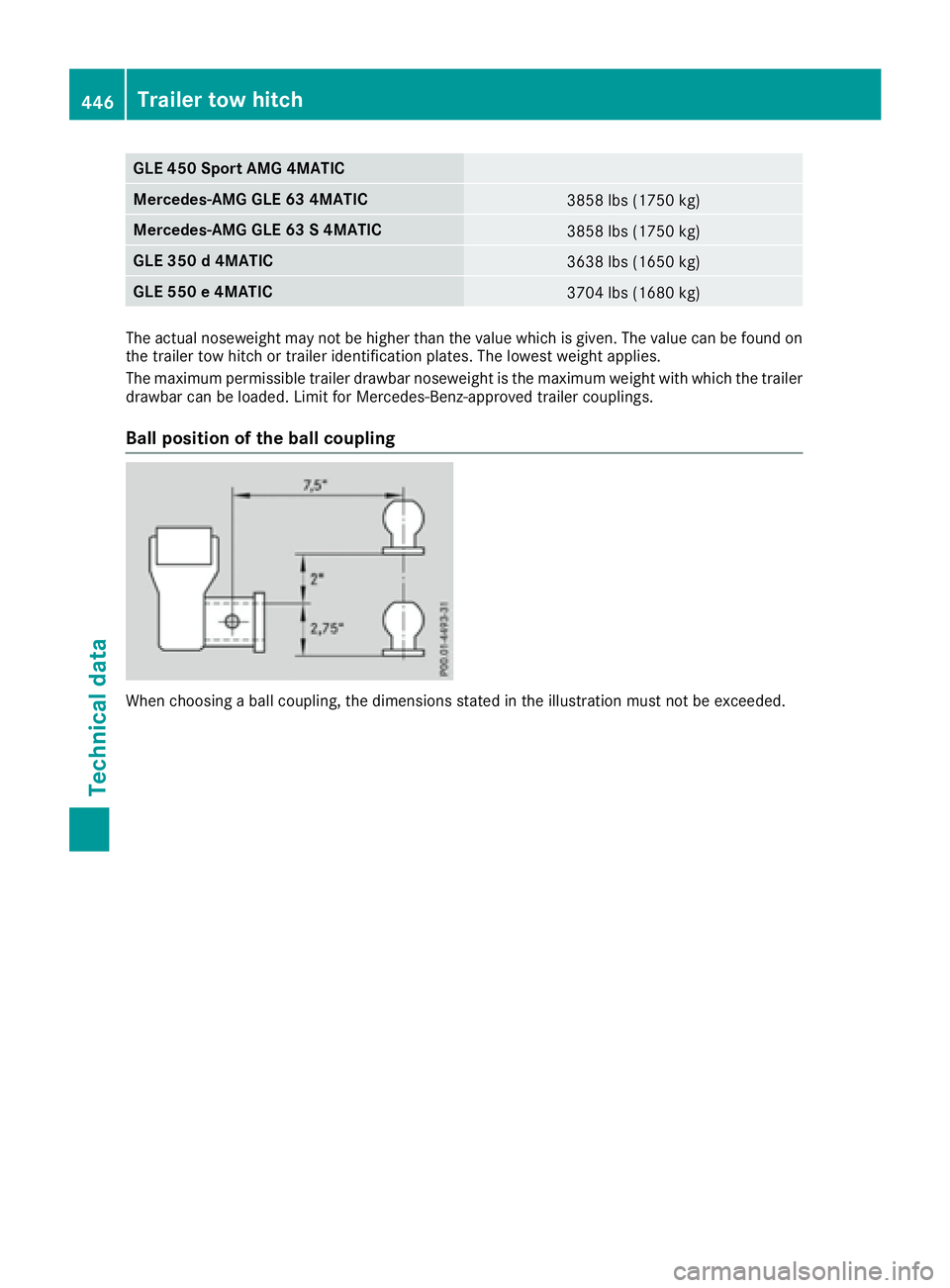
GLE 450 Sport AMG 4MATIC
Mercedes-AMG GLE 63 4MATIC
3858 lbs (1750 kg)
Mercedes-AMG GLE 63 S 4MATIC
3858 lbs (1750 kg)
GLE 350 d 4MATIC
3638 lbs (1650 kg)
GLE 550 e 4MATIC
3704 lbs (1680 kg)
The actual noseweight may not be higher than the value which is given. The value can be found on
the trailer tow hitch or trailer identification plates. The lowest weight applies.
The maximum permissible trailer drawbar noseweight is the maximum weight with which the trailer
drawbar can be loaded. Limit for Mercedes-Benz-approved trailer couplings.
Ball position of the ball coupling
When choosing a ball coupling, the dimensions stated in the illustration must not be exceeded.446
Trailer tow hitch
Technical data